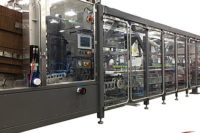
Lauren R. Hartman, Editor-in-Chief
When Gonnella acquired a plant in Aurora, Ill., more than six years ago, it installed new production equipment and overhauled much of the facility, which now produces eight luscious bread varieties-four consistently each day -and assorted bread and bun products. Eight is really a drop in the bucket considering Gonnella’s massive stock-keeping units list. According to Michael Lucchesi, vice president of operations, fresh division, the total product list for the entire company is about 14 pages long. “We make close to a thousand SKUs total, but we produce them at the various locations,” he says.
Employing 80 people, the Aurora fresh-product plant supplies contract customers, including two of the largest “soup” companies in the country. The plant starts its baking shift at 11 p.m. There are two makeup lines-one for bread and another for buns-that feed a 125-ft.-long tunnel oven. Production starts off with bread-baking and then migrates to producing buns, then back to bread and back to buns. “We change over the product on the lines on a daily basis,” Lucchesi explains. “We have a significant national presence in frozen dough and achieve the same type of presence in fresh-baked items.”
Equipment efficiencies and reliability are critical to this large-volume plant, he adds, which can output as much as 12,000 lb. of product an hour. Safety is also of utmost importance, and the company aims to achieve the highest standards in customer safety, including top inspection scores. Inspected regularly, the 80,000-plus-sq.-ft. Aurora plant recently earned a superior rating from AIB.
Programmable logic line controls are in place “and the lines can talk to each other,” notes Lucchesi. “The plant was laid out very effectively. It’s very spacious here, compared to some of our smaller, land-locked facilities in the city [of Chicago], so we have a lot of room to operate here.”
There are several quality control points located throughout the facility and one Hazardous Analysis Critical Control Point (HACCP). Each line receives daily maintenance and inspection, the latter from a quality control inspection operator.
Delivering product six days a week, the Aurora plant, like the other Gonnella facilities, accommodates sustaining orders and can take orders by phone or the Internet. Orders are processed for the next day starting at 4 p.m.
On the morning ofSnack Food & Wholesale Bakery’svisit, the bun line was producing aromatic, buttery sandwich rolls for childrens’ meal kits.
Mixing, rounding, dusting
At the head of the line is a mixing area, equipped with two mixers that accommodate the bread line and the bun line, with one mixer used for each line. In full production, both mixers are used for each line. Located on the outside of the plant are three flour silos that each hold about 100,000 lb. for production of the fresh products, which carry a three-day shelf life but last for as long as 14 days, depending on the item.
Minor ingredients are scaled and manually dumped into one of the mixers. Flour and other ingredients are conveyed directly into a scaling (weigh) hopper located above each mixer. The hopper, which can hold 1,200 to 1,300 lb. of dry ingredients, opens directly into the mixers. Water and other liquid ingredients are pumped into the mixers and the dough is then mixed for several minutes. The mixed dough then drops through a “slide” and into a dough pump.
The dough then conveys on a long belt to the roll makeup line and heads to a bun divider system. At this point, the line turns at a 90-degree angle and progresses in a long continuous flow into two hoppers leading to the divider. The dough then moves under a set of rounding bars to a flour duster chute that prevents the dough from sticking (the flour dust is re-circulated into the system).
Each divider creates four portioned balls of dough at a rate of about 400 pieces per minute. The dough balls are dusted with flour using the zig-zag dusting chute. At this point, if the product is to become a round bun, it’s deposited directly onto a pan. If it’s molded, the dough balls are immediately conveyed to an intermediate (pocket) proofer.
After a short resting time, the dough pieces drop out of the proofer pockets and onto a molding board and are then indexed into pans that hold 40 buns each (the amount varies, depending on the size and shape of the bun or other item being made). The large pans continue conveying downstream to the final proofer, which proofs the dough at temperatures of 96-98ºF (this also varies with the product being made) for an hour.
“This line can produce hamburger, hot dog, sub buns and several other items,” Lucchesi notes.
Just prior to proofing, line operators check the rolls for proper pan placement. “If the bun is overlapping or not centered properly in the pan, it’s unacceptable and it’s removed,” he says.
After the buns are proofed, they are automatically scored on the top and are conveyed to a staging area. “This gives the buns some time to skin over on a circulating conveyor before they go to the oven,” says Lucchesi.
Then, the scored buns make their way into the large oven, which bakes at 400-410ºF, for nine to 30 minutes, again depending on the product. “We’re equipped here to use pans or peel boards for certain types of hearth breads,” he continues.
In the first stage of the oven, the scores open on the tops of the rolls while a golden-brown crust sets in the second stage of baking and the rolls achieve a warm golden color, or bloom, Lucchesi explains.
Quality control checks
After baking, the buns are then automatically de-panned and placed on spiral cooling conveyors where they cool at ambient temperatures for approximately an hour. Meanwhile, the empty pans convey back to the front of the line to be re-circulated into the system. Before the pans are reintroduced into the line, they are tilted and blown off with air to remove any residuals. After cooling, the buns move through a metal detector system and are bagged in the packaging area. The clear bags are automatically clipped closed with a bread bag clip that incorporates a production code.
“A quality control test is performed every hour of production,” says Lucchesi. The buns can also move through a set of indexers and rotary or band slicers as well as orienters if they are to be sliced, Lucchesi says. A quality check is also made at this stage to inspect for any rolls with imperfections. Measurements of the products are also taken to ensure they’re the proper height, weight and size. “This is done every 15 minutes to make sure each product fits into the packaging properly and is made to our and our customers’ requirements to ensure that the customer gets the best possible product,” Lucchesi points out.
Just before bagging, a bun stacker groups the buns into multiples. DuringSnack Food & Wholesale Bakery’s visit, the system placed six buns on top of another six buns for a 12-pack. A final quality control check is made in this area. The clear film bags are then loaded in counts of five into the shipping trays while sensors help control bag pattern feeders that orient the bags of buns for placement into the trays. The trays convey to the shipping area where they’re stacked and loaded onto trucks ready for shipment. The closed-loop system requires that the trays returned from customers be washed in an automatic tray washer before being reused.
“The bread line operates almost the same way, and we can place six bags of bread on a tray,” he says. The plant runs two shifts, eight hours a day, five days a week.
Even though it’s very well established, Gonnella isn’t set in its ways. “We are innovative,” Lucchesi continues. “In terms of our production, there is a lot of innovation in this world-class plant. We’re dealing with some of the biggest food manufacturers in the world and we’re competitive. We win their business because we’re dedicated, compassionate, innovative and high-capacity. A lot of blood, sweat and tears end up culminating at this plant.”
What’s ahead?
Aside from adding two new indexers on the bun lines to pick up 1-2% percent of additional throughput, and some packing pattern conveyors, the Aurora facility is still new enough that major equipment changes or additions are not necessary for the foreseeable future. “We upgrade equipment on a continuous basis,” Lucchesi says. “We have various new things on the drawing board, and have customers who we’re talking to right now on things that could take us into new levels of production. But at this plant, we’re most concerned with maximizing product throughput, one efficiency at a time. As we expand into different markets, our next big investment could be on the packaging end, in terms of robotic palletizing and getting things ready for shipment without missing a stroke.”
As far as the packaging itself goes, the retail packaging recently got a graphic revise, and Gonnella as a company is investigating ‘green’ or sustainable packaging.
Other environmental initiatives include adopting more energy-efficient lighting systems and upgrading to more environmentally-friendly motors, Lucchesi says. “We recycle plastics, paperboard, food and other materials. Food that doesn’t make it to end users is reprocessed into animal feed and other things. Used motor oil and oils used in the systems are sent to recyclers.
“We’re a pretty light footprint of an industry. We use a lot of power, but only at optimal times,” he continues. “We don’t operate in the high-energy-use hours and we wind down production at mid-day, so our power profile is ideal. At our other plants, it’s also ideal and our frozen dough plants try to balance out their energy power needs with respect to the community.”
The beat goes on
The lines at this facility hum along every day (and night), without missing a beat. That’s the whole idea, says Lucchesi. “If our customer wakes up and doesn’t see his bags of bread delivered to his shop or store, he’s in trouble,” Lucchesi says. “We can’t allow that to happen. We’ve gone through a lot over the years and survived all sorts of circumstances-we even ran out of flour once -but the bread gets out. We have always maintained the operation.”


